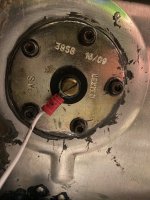I have the early model Prinston puck senders and they need to be repalced, the output voltage is not consistant.
I need to replace them in a flying 10. Has anyone removed the senders without pulling the tanks? of if you think its possable?
Red Avionics bought Prinston and has the design, they can build new senders for me.
Option 2 is to go back to float style, If I do go floats can I get them installed without pulling the tanks?
I'm not sure what direction to go....
One other question is the hole pattern typical for all senders or is that going to be a problem?
Thanks for the help.
I need to replace them in a flying 10. Has anyone removed the senders without pulling the tanks? of if you think its possable?
Red Avionics bought Prinston and has the design, they can build new senders for me.
Option 2 is to go back to float style, If I do go floats can I get them installed without pulling the tanks?
I'm not sure what direction to go....
One other question is the hole pattern typical for all senders or is that going to be a problem?
Thanks for the help.





